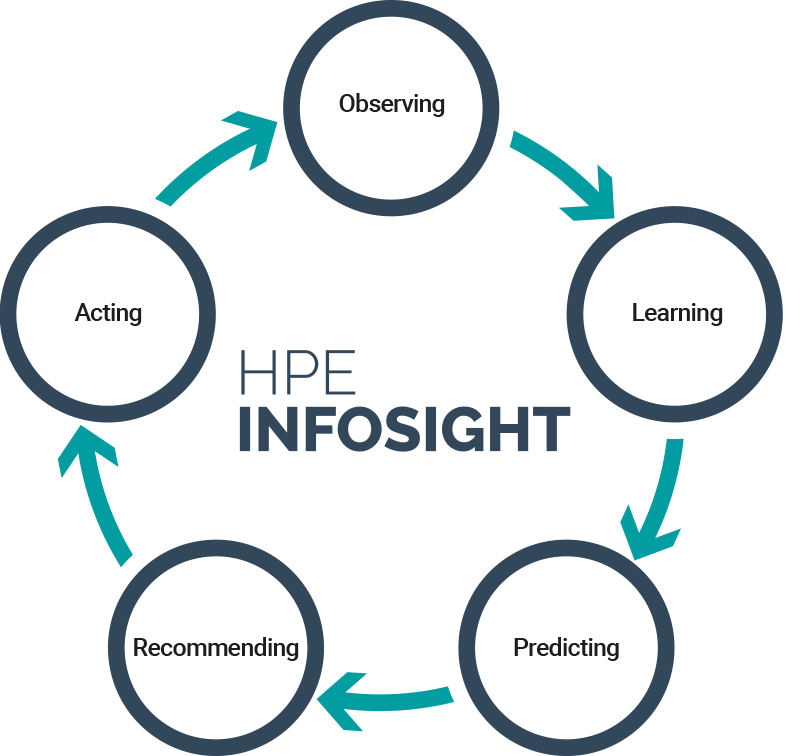HPE InfoSight for Servers: Unlocking AI-driven Operations
In today’s rapidly evolving digital landscape, businesses are constantly challenged to manage and optimize their IT infrastructure efficiently while ensuring uninterrupted operations. With the ever-increasing complexity of server environments, traditional manual approaches to monitoring and troubleshooting are insufficient. To overcome these challenges, Hewlett Packard Enterprise (HPE) has introduced a groundbreaking solution – HPE InfoSight for Servers, harnessing the power of Artificial Intelligence (AI) to unlock a new era of intelligent and automated operations.
HPE InfoSight for Servers is an advanced AI-driven platform that revolutionizes server management by proactively addressing potential issues before they impact business operations. Utilizing an extensive data collection network, it gathers vast amounts of operational data from millions of servers worldwide. This data is then analyzed using cutting-edge machine learning algorithms, enabling InfoSight to identify patterns, predict future trends, and make actionable recommendations.
Unlike traditional server management tools that rely on reactive measures, HPE InfoSight takes a proactive approach.
HPE InfoSight for Servers

HPE InfoSight for Servers is a revolutionary technology developed by Hewlett Packard Enterprise (HPE) that aims to transform how server infrastructure is managed. This innovative solution leverages artificial intelligence (AI) and predictive analytics to enhance servers’ performance, reliability, and efficiency across diverse environments.
The ever-increasing complexity of modern IT infrastructures necessitates intelligent tools that can proactively analyze, predict, and resolve potential issues before they impact critical operations. HPE InfoSight for Servers is designed precisely for this purpose. Collecting and analyzing vast amounts of operational data from thousands of servers around the globe enables administrators to gain comprehensive insights into their server infrastructure’s health and performance.
One of the critical features of HPE InfoSight for Servers is its ability to identify potential problems even before they occur. Leveraging machine learning algorithms, it analyzes historical data patterns. It compares them with real-time operational data to identify anomalies or deviations. Doing so empowers administrators to take proactive measures to prevent issues such as hardware failures or system bottlenecks.
The Evolution of AI in Server Management

With the rapid technological advancement, Artificial Intelligence (AI) has emerged as a game-changer in various domains. In recent years, AI has made significant strides in server management, revolutionizing how servers are monitored, maintained, and optimized. This section explores the evolution of AI in server management, highlighting its benefits, challenges, and future potential.
Evolution of AI in Server Management:
Automation and Efficiency
Traditionally, server management was a time-consuming and manual process that involved monitoring server health, troubleshooting issues, and ensuring optimal performance. However, with the introduction of AI, tasks that human operators once performed can now be automated, leading to increased efficiency and reduced operational costs. AI algorithms can continuously monitor servers, detect anomalies, and take corrective actions without human intervention. IT professionals can focus on more strategic and complex tasks rather than mundane maintenance activities.
Predictive Analytics
AI-powered server management systems leverage predictive analytics to anticipate potential failures or performance bottlenecks before they occur. These systems can identify trends and anomalies that may lead to system downtime by analyzing large volumes of historical data and patterns. Proactive alerts and recommendations provided by AI-based tools enable administrators to take preventive measures promptly, minimizing downtime and ensuring smooth server operations.
Intelligent Resource Allocation
AI algorithms can analyze server workloads and resource utilization patterns to optimize resource allocation. By dynamically allocating resources based on real-time demand, AI-based systems can ensure efficient server capacity utilization and prevent over-provisioning or underutilization. It improves server performance and reduces energy consumption and operational costs.
Security and Threat Detection
AI has enhanced server security by enabling advanced threat detection and response capabilities. AI-powered systems can analyze network traffic, user behavior, and system logs to identify potential security threats like malware attacks or unauthorized access attempts. They can also proactively respond to these threats by implementing security patches or reconfiguring firewalls. AI-based security systems can constantly adapt and learn from new threats, improving their ability to detect and respond to emerging cybersecurity risks.
Intelligent Automation
Integrating AI with server management tools enables intelligent automation of various tasks, reducing manual effort and human error. For example, AI algorithms can automate software updates, patch management, and backup processes, ensuring that servers are always up to date-and protected against vulnerabilities. Additionally, AI can automate capacity planning and scalability decisions by analyzing historical data and predicting future demand trends.
The Challenges in Server Management Before AI

Before the advent of Artificial Intelligence (AI), server management posed numerous challenges that required substantial human intervention. These challenges encompassed a wide range of complexity and impacted various aspects of system administration.
1. Manual Monitoring and Troubleshooting
Server management relied heavily on manual monitoring and troubleshooting techniques. System administrators had to monitor server performance, track resource utilization, and manually identify any issues or bottlenecks. This approach was time-consuming and prone to errors, as humans could easily overlook critical indicators or fail to identify subtle performance issues.
2. Reactive Maintenance
Without AI-driven predictive maintenance systems, server management was predominantly reactive rather than proactive. System administrators would typically respond to issues after they occurred, often resulting in undesirable consequences such as system downtime, loss of data, and decreased efficiency. The lack of an intelligent system that could forecast potential problems made it challenging to address them before they escalated into significant disruptions.
3. Scalability Issues
Scaling server infrastructure to cope with increasing demands was a significant challenge without AI assistance. Estimating future resource requirements accurately took time for system administrators, often leading to under-provisioning or over-provisioning of servers. It resulted in inefficient use of resources, increased operational costs, and difficulty accommodating sudden surges in user traffic.
How HPE Infosight Integrates With Existing IT Infrastructures

HPE InfoSight is an intelligent data management platform that integrates seamlessly with existing IT infrastructures to provide enhanced visibility, proactive monitoring, and predictive analytics. Its integration capabilities enable organizations to make the most of their investments in hardware, software, and networking by providing real-time insights into the health and performance of their infrastructure.
One of the critical ways HPE InfoSight integrates with existing IT infrastructures is through its support for a wide range of industry-standard protocols and interfaces. Whether SCSI, iSCSI, Fibre Channel, or SAS, InfoSight can monitor and analyze data from various storage systems. This level of compatibility ensures that organizations can leverage their existing storage investments without needing expensive hardware upgrades or replacements.
Furthermore, HPE InfoSight integrates seamlessly with popular hypervisors such as VMware vSphere and Microsoft Hyper-V. It leverages APIs provided by these hypervisors to collect data on virtual machine performance, resource utilization, and capacity planning. By integrating with these hypervisors, InfoSight enables organizations to have a holistic view of their virtualized environments and optimize performance across their virtual machines.
Another critical aspect of how InfoSight integrates with existing IT infrastructures is its ability to work with different operating systems.
Final Thoughts
HPE InfoSight for Servers is unlocking AI-driven operations and revolutionizing how businesses manage their server infrastructure. This innovative platform offers unprecedented visibility, automation, and predictive capabilities by harnessing the power of artificial intelligence and machine learning.
Gone are the days of reactive IT management, as HPE InfoSight enables proactive problem-solving by continuously monitoring and analyzing server health. It means issues can be identified and resolved before impacting performance or disrupting operations.
Moreover, predicting and preventing potential problems saves valuable time and minimizes downtime and repair costs. With HPE InfoSight for Servers, businesses can optimize their server environment, improve efficiency, and ultimately enhance the overall productivity of their operations.
ICT Distribution Bangladesh is the perfect distributor for HPE when it comes to stability, efficiency, and affordability. As a trusted partner, we are dedicated to ensuring the success of your business by providing outstanding service, well-informed staff, and cutting-edge technologies. Feel free to contact us today and begin a fruitful partnership without hesitation.
Latest Posts

Comparing HPE Storage Server Models: Which One Suits Your Needs?

How HPE’s Innovations Are Shaping the Next Decade of Technology
Beyond Antivirus: Why Kaspersky Total Security is Your 2024 Digital Guardian

Comparing HPE Storage Server Models: Which One Suits Your Needs?



